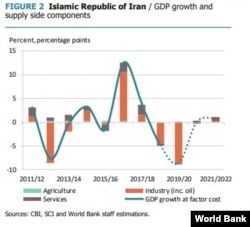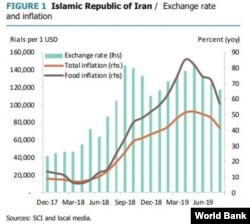Iran's economy will shrink by a massive 9.5% this year, the International Monetary Fund (IMF) said in its World Economic Outlook report on Tuesday, October 15.
Based on the same report, the Islamic Republic's economy has further deteriorated from a previous estimate of a 6% contraction.
The new data highlight Tehran's worst economic performance since 1984 when the Islamic Republic was at war with neighboring Iraq.
Iran's economic growth last year was -4.8% and will be 0% next year, IMF said, which means after an overall contraction of more than 14 percent, it will not grow.
Furthermore, the report shows that Iran alongside Venezuela, will have the least economic growth in the world.
A week earlier, the World Bank had also forecast a -8.7% growth for Iran, which is struggling under the U.S. sanctions.
However, the World Bank estimate is based on the presumption that Iran would be able to export half a million barrels of crude oil per day, but figures provided by the international oil tanker tracking companies show that the Iranian oil exports in recent months have been less than 300,000 barrels per day.
Meanwhile, Iran delivered a substantial amount of crude to China's Sinopec and CNPC in exchange for their investment in developing Azadegan and Yadavaran fuel fields. Another significant amount of Iranian oil was exported to Syria, while it is not clear if Damascus pays for the oil or not.
The IMF says that the inflation rate in the current year in Iran will be 37.5 percent, but the World Bank's estimate is slightly more pessimistic, amounting to 38.3 percent. This is on top of high inflation last year.
Both the IMF and the World Bank have estimated Iran's inflation rate to have been 30 percent last year.
The main reason for Iran’s inflation is the devaluation of its currency, which has dropped more than threefold against other currencies.
A day earlier, the Islamic Republic President Hassan Rouhani had claimed, "Point-to-point inflation has reached 34 percent, down from 52, and we expect the downward trend to continue until the end of the year."
The inflation in Iran is highest in the world after Venezuela and Sudan.
In its previous report, the IMF had forecast Iran's economy to contract by 6 percent this year, but that estimate preceded Washington's decision in April to end six months of waivers, which had allowed Tehran's eight biggest oil buyers to continue importing limited volumes from the Islamic Republic.
In sharp contrast with the IMF and the World Bank data, the governor of the Central Bank Iran (CBI), Abdolnasser Hemmati claimed on Monday that "despite the enemies' maximum pressure", CBI, along with the Rouhani's Administration, succeeded to stabilize Iran's market and economy.







